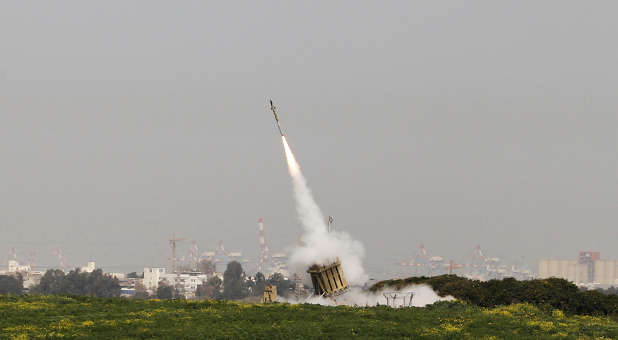Just to be clear: I’m a huge fan of Israel’s “Iron Dome” rocket and missile defense system. It’s downright miraculous, and it’s saving a lot of lives, probably including my own.
As readers of this column know, my Joshua Fund colleagues and I were in Israel for the entire eight-day war with Palestinian terrorists in Gaza. Numerous times we heard the air raid sirens go off and had to run into bomb shelters with our Jewish and Arab friends. We also personally witnessed the Iron Dome system in action—its interceptors zig-zagging through the skies over Ashkelon, for example, at supersonic speeds and destroying the incoming rockets with earth-shaking booms.
The results were stunning. The system destroyed about 421 of the 1,500 or so rockets fired at Israel, and with a success rate of some 90 percent. In the end, only six Israelis died during ”Operation Pillar of Defense,” despite the near constant barrage of Palestinian attacks. Sadly, most of those were from fathers standing outside to watch the rocket war, while their wives and children were safely inside their bomb shelters.
The Israeli-designed system can determine whether a Palestinian rocket will land in an open field or on a house or business. If the former, Israel doesn’t fire an interceptor, thus saving money. If the later, Israel fires multiple interceptors to destroy the incoming rocket before it can do damage or kill. An interceptor in mid-flight that misses its target or isn’t needed automatically self-destructs so as to minimize further casualties.
Understandably, Israelis are in love with the new system. They’re ecstatic that they have a new level of protection. They know the system is not perfect, but it’s better than they had in the last war, and they know it’s steadily improving and is making the job of Iran, Hamas and Islamic Jihad that much harder.
One of the issues my colleagues and I discussed while we were in Israel was the high cost of the Israeli interceptors. That’s why I was so intrigued this morning when I read a fascinating story in the Jerusalem Post about the Iron Dome. Consider:
- Israel’s cost per interceptor is dropping: The Post noted that while the cost of each interceptor originally built for the system was between $40,000 and $50,000 a piece, most of those costs were R&D related. Now the cost of producing new interceptors is dropping fast as Israel produces more of them. “Iron Dome’s Tamir interceptors don’t really cost $40,000 to $50,000 each to manufacture,” reports the Post. “Like any high technology system, the vast majority of the costs of Iron Dome are systems development and manufacturing setup. These fixed costs are spread over the number of items estimated to be manufactured and priced accordingly. However, if the number of items produced substantially exceeds the initial estimate, costs drop proportionately. The actual marginal cost of production of a Tamir interceptor is low and reflects the costs of the basic raw materials; metal, fuel, explosives and electronic components used in its manufacture, and the labor required to run the assembly line. If the IDF ends up ordering 10 times as many interceptors as originally estimated, then their ‘cost’ will likely drop to around $5,000. At 100 times as many the “cost” will approach the marginal cost of less than $1000.”
- The Iron Dome’s shoot-down accuracy is improving: “Iron Dome is fundamentally a highly advanced computer system with a very rapid upgrade cycle,” reports the Post. “So far Iron Dome is matching pace with the iPhone for major software and hardware upgrades, and consequent performance increases. This will not only continue but will actually accelerate in accordance with Moore’s Law and Ray Kurzweil’s Law of Accelerating Returns which state that the performance of computer systems increases exponentially with time. With each upgrade the interception rate will improve and the range of missiles it can intercept may also improve further. It is therefore that we can expect Iron Dome to reach a 95 percent or higher interception rate in the next year or two, and to continue to improve as the speed and processing power of the computers that make up its brain and eyes (radar) advance. The practical upshot of this is that the number of rockets per Israeli fatality has risen from 50-75 (Lebanon and Gaza pre-Iron Dome) to 300 in 2011 (75 percent interception) and around 500 in 2012 (90 percent interception), despite Hamas using more lethal rockets.”
- Iran’s and Hamas’ costs per rocket—and per Israeli killed—are soaring: “The real cost of the rockets and missiles which Iron Dome intercepts is vastly underestimated by most commentators,” the Post asserts. “Grad rockets may well cost Iran only $1,000 each on the open market, but this is not the delivered cost to Hamas in Gaza. The supply line from Iran to Gaza is an extremely convoluted and expensive one which involves huge losses from IAF action bombing convoys and factories in Sudan, and interception by western navies. Large bribes have to be paid at every step of the way, particularly to the Beduin in Sinai and the Egyptian soldiers in Rafah who are supposed to be stopping the smuggling. And the losses continue once the Grad gets to Gaza, with the IDF regularly destroying rocket caches. Thus, 1,000 Grads, which cost Iran $1 million to purchase, may end up as 300 Grads which cost a further $2 million in ‘delivery charges.’ This turns a $1,000 Grad rocket in Iran into a $10,000 Grad rocket in Gaza. … The strategic implications are that the current rocket-based terror strategy of Hamas and Hezbollah has been rendered both ineffective and economically unsustainable. I estimate it is currently costing Hamas (and thus its patron Iran) around $5 million (500 rockets at $10,000 each) to murder a single Israeli. When Iron Dome reaches 95 percent interception rate these figures will double and at 97.5 percent they will double again.”
We could all wish the Iron Dome system—and Israel’s newly developed system to shoot down medium-range missiles, known as “David’s Sling”—weren’t needed. But they are. Let’s keep praying for peace and security for Israel and her neighbors. But let’s also be grateful for all the scientists and engineers that developed these system, for the leaders who had the foresight to insist that they be built (including Ronald Reagan who was ridiculed for insisting upon the development of missile defenses), and for the American taxpayers who have been helping to foot some of the bills.
For the original article, visit joelrosenberg.com.
Joel C. Rosenberg is the author of 10 New York Times best-selling novels and non-fiction books, with more than 2.5 million copies sold. He is also the founder of The Joshua Fund.
See an error in this article?
To contact us or to submit an article






















